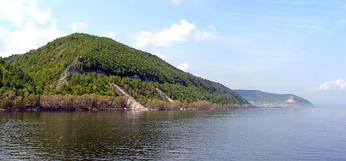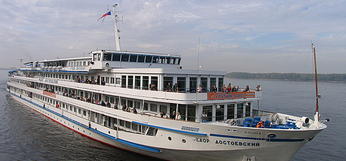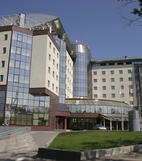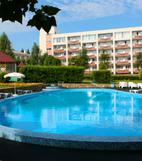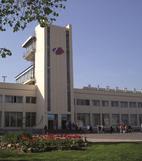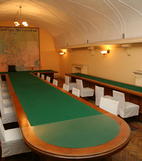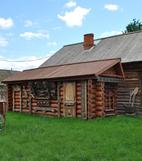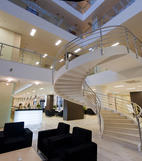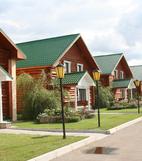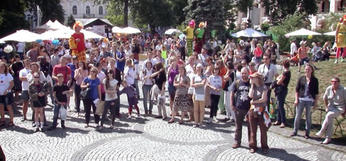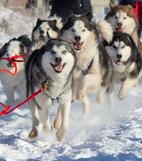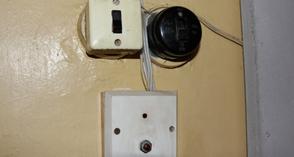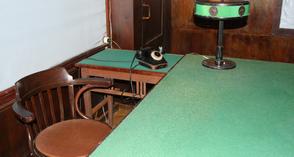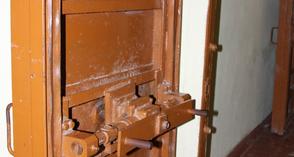Stalin’s Bunker
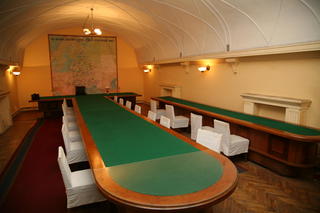
Location: 167, Frunze Street, Samara, 443010
GPS: 53.196715,50.097965
Tel. (846) 333-35-71
Description:
The building of the Culture and Arts Academy situated on Chapaev’s Square seems common to a contemporary viewer. But it is historically meaningful. Here, in 1915, the building of the new administrative centre, the gouvernour’s house, was finished. The building designed in the Italian Renaissance style by the architect P.Shamansky was financed by the local authorities. It was called “the white house” due to the purely white colour of its stone walls.
The building became the embodiment of the Samara Region cultural and economical development at the beginning of the 20th c. Its façade opened into the Saratovskaya Street (the modern Frunze Street) and was decorated with an original balcony. During 1915-1916 the owners of the building were changing; however, the gouvernour’s office and apartments were always located there. On 15.12.1917 there was an explosion in the building basement which caused the death of 8 Red Army soldiers. The “White House” needed reconstruction. From 1920 till 1928 it housed the Regional Executive Committee.
The name of the National Deputies Executive Committee which worked in the building changed several times according to the administrative and geographical division confirmed by the Central Committee of the Soviet Russia: it was called the Middle Volga Executive Committee till January 1935, the Kuybyshev Area Executive Committee till December 1936 and, at last, the Kuybyshev Region Executive Committee during the next 4 decades.
By the end of the 30-s the name “the White House” was nearly forgotten, and it was dropped completely after the building reconstruction by the project of P. Scherbakov in 1932. 3 storeys were built up and an adjoining building appeared which architecturally simplified the construction and the building lost its former resemblance to a palace.
Every person in his or her life comes across something significant and thrilling, and even mysterious.
Today you will see something which has been the great secret till recently. You will make a trip into the depth of the earth and into the depth of the history.
24.05.1991 the first excursion to Stalin’s Bunker in Samara was organized which always drew everybody’s attention.
The museum reminds us about the World War II. We seem to know a lot about these years. Nevertheless, there are still many lacunas in the history of the war. They are connected with our city as well, because it played a special role during 1941-1945.
In the yard of the very building we will pass the borderline between the present and the past time.
(The script of the excursion in the hall of the Museum near the tourist guide of the building).
We closed the door and the contemporary life of a big city with its grief and joy, problems and pleasant moments stayed outside. Her the time as if stopped in 1942. At that period, on 16.12.1942 the government committee headed by P.Hlopov, the chief deputy of the Kuybyshev Region Executive Committee signed the Act about the Object №1 admission (that was the special name of the construction we are in).
It has 3 shafts which are clearly seen on the scheme. There is the first shaft, with a lift and stairs, the second one with an emergency exit at the level 14 m. under the land’s surface, and the last one – the wide central shaft.
The storey enumeration goes upwards. At the level 34 m. under the earth’s surface there are a living room for Stalin and the State Committee of Defense Conference Hall built in case the bunker were used by the staff.
There is a special technical floor at the level 37 m. under the earth’s surface. There are sewers and clean water reservoirs.
The Bunker is quipped with lifts, yet we will go through it on foot, stage by stage.
When the museum was opened it needed only a slight interior reconstruction because it was in a perfectly good condition. Now it is the functioning object of the Civil Defense Service. Near the entrance we may see the modern picture made by Samara artists which is dedicated to the Victory Day. You see that the lights go down and some music can be heard – all that is to emphasize the first impression. (It is necessary to warn the guests about being careful while descending in the half-light: Please, be careful! Mind the steps!)
The guide stops at the lower ground of the technical mine, the music is switched off, and the light goes up.
Now we may see how a person feels in a real bunker. Everybody heard about bunkers which are built mainly as the shelters from air attacks.
The word “bunker” originates from the English language and has several meanings. In this case it is used in the meaning of “a shelter made from concrete, a longstanding protective construction”. The word “bunker” has been used in our country until recently presuming Hitler’s war shelters. E.g., there is the description of his bunker called “Wolf’s lair”, the General Headquarters in Olshtynsk, Poland, which was deserted in November 1944 and blown up in 1945 with a 10 tons trotyl (trinitrotoluol) bomb.
It was forbidden to speak about Soviet bunkers. (There is an Act taken at the 18th Congress of the RKP (b) about Bomb-Shelters Building. Some new projects of a large scope were designed in Kiev, Habarovsk, between the Sakhalin Island and the Continent. The construction we are visiting proves its realization). Stalin didn’t have to use the bunker, he never was here. However, even today, more than 60 years after the war, the place still bears the spirit of the past epoch. We have passed 8 staircases 10 steps each, which equals to 80 steps, and now we could find ourselves on the so-called technical ground located at the level 14m. under the land’s surface.
The architectural base of the bunker mines is clearly observable from here. The mine resembles an underground tunnel turned vertically. The firm reliable tubing forms the walls of the building mine which contains the lift and the staircases. The building principle of the second mine is the same, but there is no tubing.
Tubing (from the English word “tube”) is the fixing element of an underground construction. It can be made of steel, concrete or cast-iron.
We may only guess how difficult the task was which the Moscow underground constructors had to complete. They began the work in February 1942 and finished it in 10 months, at the end of November. It is hard to believe in it, because even now possessing the modern equipment the open building of an underground station sometimes takes more time. And than practically everything was done by hand, with a pick and a shovel. And the works were completed secretly on the limited territory. The building was carried on under the strict control of National Commissariat of Inner Policy (NCIP) agents.
The scope of the works:
- ground workings – 25 000 sq.m.
- concrete laying – 10 000 tons
- metal constructions laying – 5 000 tons
- the tubing material – cast-iron
- the mine diameter – 6,5 m.
- the thickness of the concrete blanket – 1 m. (according to the project).
There are no analogues in the quantity and the period of the building (to show the fixing elements and the construction parts of the tubing).
The part with the open upper side is the technical entrance to the main construction. We enter it through the tambour lock №1 and go to the special “fork” to see the life support system of the bunker.
There is a special mark at the end of the corridor – the grate door which closes the emergency exit. This is the smaller mine with a light metal ladder, the so-called gangway climb. Such a ladder went parallelly us when we were descending, but we couldn’t see it because of the half-darkness (you could take the notice of it on our way back).
It is completely safe to stay at the level 14 m. under the earth where we are now, because there is a concrete laying (1m. thick) in the earth and 3meters of concrete under the main part of the construction which we haven’t seen yet.
The depth of Hitler’s Bunker in berlin is 16 m., in Vinnitsa – 12m. W. Churchill’s shelter in London was only 2 storeys deep, and Roosevelt’s shelter also was 2 storeys deep.
Stalin set the task to build the 34m. deep shelter which needed the additional mine building.
At this point the metal door leading to the underground autonomous electric power station is clearly seen. The engine and the fuel tank which went through the underground pipe are put there.
The local electric power supply is supported by the underground electric wire from the city power station, and in one of the service rooms that we will pass soon there is a supply of electrolyte batteries for 3 days which could serve 100 people. These are parameters of Object № 1 living facilities, which was the name of the bunker in the official building documentation.
(We are passing the tambour lock №2)
For the first time you could see such doors with horn-like screw locks. We are going through the narrow corridor and very soon without any descending we will leave the lower ground of the first mine and enter the upper ground of the second mine.
Let us look around first.
There is also a lift and a staircase, but it is the central mine, that’s why its diameter is more than 8 m. That gives the opportunity to place some cabinets on the floors. The mine is plastered and provides everything for safe and fruitful work.
(You could show the location of the group on the evacuation scheme on the wall).
The guide should draw the attention to the good condition of the genuine wooden construction remained from the 1942 – boxes for keeping fire hoses, doors, banisters.
There are letters on the door – FVC. That means “filter and ventilation camera”. It was likely to be transferred here from the Moscow Underground storage supply or, perhaps, it was made according to the special State demand.
The system of air conditioning is functioning. We may hear the noise of the moving air, but it doesn’t cause any unpleasant feeling due to the large space of the mines and rooms. The systems of water and air supply and the sewers are doubled.
On the 5th and the 6th floors there are service rooms which are not visited by us because they are rather narrow and densely equipped. Electricians, couriers, etc., worked there.
Today, on the 4th floor, there are exhibits telling the history of the Civil Defense Service maintained by the Ministry of Air Defense from the World War II to the present days.
(The group is visiting the first opened cabinet).
On each floor opposite the cabinet there was a sanitary block – the washstand and the toilet. Today the sector doesn’t function.
On the 3-d floor we may see the map of the Samara Region as the part of the exposition.
(The guide gives some comments, if necessary).
The Samara Region is situated in the southern-western part of the European territory of Russia, in the middle flow of the Volga River, the biggest river in Europe. Its occupies 0,31% of the total Russian territory. It borders with Tatarstan in the north, with the Saratov Region and Kazakhstan in the south, with the Orenburg Region in the east, with the Ulyanovsk Region in the north-west. The Region stretches at 335km. from the south to the north and at 315 km. from the west to the east.
Samarskaya Luka, the unique nature monument of the world meaning which is situated in the middle flow of the Volga (which is divided into the chain on big water reservoirs) is the distinctive geographic feature of the region. Moreover, Samarskaya Luka is the geometric centre of the region taking the place inside the peculiar industrial half-circle created by the Samara-Togliatti conglomerate.
There are 27 agricultural districts and 12 cities in the region. Gas, oil and ammonia pipes are marked on the map as the objects with high ecological danger potential. The objects are under the special control of the Civil Defense Service and the Ministry of Emergency Situations.
On the 2d floor there is an exposition devoted to defense from nuclear and chemical attacks and special defense medicine. The picture with a model shows the in detail the consequences of a nuclear explosion in a small town.
The exhibition is formed for the training of special groups according to the qualification up-grading programme organized by the administration of the museum (the Civil Defense Service and the Ministry of Emergency Situations) for their members.
On the 1st floor there is an exposition telling about the role of Samara in the WWII. We will visit the exposition.
(The guide stops in the exhibition hall “Kuybyshev is the 2d capital of the USSR”).
Various documents, photos, materials which present Kuybyshev as the double for the capital of the USSR during the WWII are collected here. Let us go back to the tragic summer 1942 using the two-coloured (red and black) map of the USSR.
On 22.06.1941 the Presidium of the USSR Supreme Soviet announced about the mobilization of the recruits born in 1905-1918 and introduced the martial law in some western parts of the country.
29.06.1941 the programme of resisting the enemy forces and defeating them was performed in the directive of the National Commissars Soviet of the CC RKP(b).
30.06.1941 the special executive body, the State Committee of Defense (SCD) with Stalin heading it was established by the decision of the Political Bureau of the CC RKP(b). It was the supreme ruling body in the country which functioned till the 4.09.1945.
The members of the SCD were: I. Stalin, Head of the Committee, V. Molotov, deputy assistant secretary, K. Voroshilov, G. Malenkov. In 1942 N. Voznesensky, A. Mikoyan, L. Kaganovich also became the members of the Committee, as well as N. Bulganin did in 1944.
The range of the problems with which the Committee dealt was wide. During the years of the war at about 10 000 questions concerning the war and the home economy were solved by the Committee. At the beginning of the ware the enemy advanced at 40-50 km. per day. In autumn 1941 when the battle for Moscow began the resolution of the SCD (15.10.1941) was taken to evacuate the capital. This resolution was published in its complete form by Academician A. Samsonov only in 1988. According to it the evacuation of Moscow began in October- November 1941(to read the Resolution aloud).
The bodies of the SNC, the State Planning, National Commissariats (NC) of Foreign Affairs and of Aircraft Industry and the Diplomatic Corps were moved into Kuybyshev, the NC-s of light industry and electric power stations were moved into Syzran, the NC of river navy was placed in Ulyanovsk, the NC of fishing industry was located in Astrakhan. A number of NC were put in Gorky (Nizhniy Novgorod now), Sverdlovsk (Yekaterinburg now), Perm. The centre for each NC was chosen considering the number of local enterprises and plants of the corresponding industry. However, the operation groups of the evacuated NCs stayed in Moscow.
In relation to that on 25.10.1941 the CC RKP(b) and the SNC charged the deputy of the SNC Head – N. Voznesensky, to represent the Government of the Soviet Union in Kuybyshev.
The secretary of the CC RKP(b) A. Andreev who was in Kuybyshev with some other members of the CC was given power to make orders and give instructions to the Regional Committees of Ural, Povolzhje, the Middle Asia and Siberia by the decision of the Politburo (25.10.1941).
(the History of the USSR and its Law, V.II, p.336).
M. Kalinin, the head of the Presidium of the Supreme Soviet worked in Samara. You can see the photos of some buildings where the representatives of the state administration and the Party were placed.
This photograph shows the members of Presidium gathered here at the official meeting devoted to the 24th anniversary of the October Revolution which took place on 6.11.1941 in our city, in the Cultural Centre of V. Kuybyshev on the main square of the city.
Why Kuybyshev was chosen as the reserve capital of the USSR?
It is evident that the reserve capital should be situated on the Volga. The great river was the most important oil and freight waterway, moreover, Moscow was connected with it. The next territory suitable for the capital was Ural. That’s why some historians believed then that Sverdlovsk would be chosen by the government. But the “main city of Ural” was too far from the centre. General Tatekava, the Ambassador from Japan in Russia joked on this account: “…I know that Hitler is preparing to enter Moscow, …and Stalin is going to Sverdlovsk, but he couldn’t rule the country from there.” It was easier to rule the country from the Volga.
In addition to that, to evacuate the capital to the Volga had another principal meaning – it set the border which was the last point for the Soviet Forces to withdraw. There were many big cities on the Volga where the government and the Embassies could be placed – Gorky (the cont. NizhniyNovgorod), Kazan, Ulyanovsk, Kuybyshev (the cont. Samara), Saratov, Stalingrad (the cont. Volgograd), and Astrakhan. So, why Kuybyshev was chosen?
Evidently, the cities situated on the right bank of the Volga (at the bank open for the direct German Army attack) dropped at once. The experience with defence of Stalingrad proved the supposition – the city called after the Leader was nearly completely captured and ruined by the Nazis, and the opposite bank of the river was preserved by the Soviet Army. The counterattack called the “Stalingrad Pot” began from there. Thus, only the cities located on the left bank of the river were suitable for the evacuation of the capital – Kazan, Kuybyshev, Astrakhan. Astrakhan was too remote from the centre. And Kuybyshev was the important railway point, it was connected by the railway with Ural, the Far East, and the Middle Asia. Kazan and Astrakhan were aside from the significant railway.
Kazan was also a national centre of Tatarstan. This fact, unimportant for a common city, becomes crucial when the suitable place for the capital was chosen. Kazan, conquered in 1552 by Ivan the Terrible, could suddenly remember the past offence, and Stalin considered himself a specialist in national questions. By the way, for the same reason Saratov, evidently, had no chance to become the reserve capital. It was the centre of assimilated Germans in Povolzhje and seemed to be dangerous during the war with Germany. Thus, only Kuybyshev left. There was no hydro power station than, so, there was no danger that the dam would be blown up and the city would be flooded.
From 17.10.1941 (on that day the resolution of the SNC USSR “About the local preventive measures against air attacks in Kuybyshev” was confirmed) the blackout began to be used in the city. In fear of possible bombings (once German pilots tried to attack the Syzran railway bridge, but the anti-aircraft fire ruined their plans) the curtains made of thick black paper were hung on the windows and soldiers on duty walked along the streets checking the disguise. The lights of cars which were few then in the streets were also darkened. At the same time, the electric power was being saved, that’s why the voltage was diminished twice and mainly kerosene lamps began to be used.
There were long queues near the shops. People went to get their scanty norms of grits, fat and bread according to cards. There was only rye bread delivered in covered plywood vans drawn by horses. Besides the product cards, the cards for rubbers (galoshes), shoes, trousers and dresses were sometimes given out. Nobody rejected them even if the goods didn’t suite at all – all the things could be exchanged or sold later. There was the market for those who were not content with the state supply. A loaf of rye bread cost 300 rubles, a half-boat of vodka cost 500 rubles. There were few stands in the city which sold beer, 2 rubles a mug.
The gardens near Samara were frozen in winter in 1941-1942. Many smokers began using makhorka and samosad (poor tobacco). The tea was made of beats or carrots. There was no sugar; people rarely could get even saccharine.
The life concentrated in black loud-speakers which hung on the poles in the city. The radio programmes broadcasted only short reviews of Soviet Informational Bureau with Levitan’s voice, sound letters to and from the front, marshes, and Russian Folk Songs.
In December 1941 the building of the radio station began in Kuybyshev whose capacity was equal to that of the Comintern. The Executive Committee of the Comintern headed by G. Dimitrov went to Samara.
We could only suppose how the question about Stalin’s arrival was being solved, yet the opportunity remained. However, there are opposite views on the problem. Thus, Molotov wrote: “Stalin didn’t hesitate. He was not going to leave Moscow.” But he wrote that in his memoirs after the war. Besides, the temporary Stalin’s arrival in Kuybyshev was more than probable. In any case, there was the necessity to build the shelter if there were any bombing. In autumn 1941 the project of the bunker was designed and than its building began.
The city cannot be considered the capital if it is not recognized by the foreign diplomacy. The presence of foreign embassies and missions in the city confirms the international status of the reserved capital.
W. Assarson, the Sweden ambassador in the USSR in 1940-1944 wrote in his book “In Stalin’s Shadow”: at the very beginning of the war some diplomats, the American ambassador in Russia L. Steinhardt in particular, raised the question of the diplomacy block evacuation. But Molotov turned down his proposal…General Tatekava (the Ambassador from Japan in the USSR) visited me on 12.10. and asked what the news was about the evacuation. I answered that I knew nothing”.
On 15-16.10 the diplomacy missions went to Kuybyshev by train. On 19-20.10 only they arrived in the “reserve capital”. To provide their safe work the members of the NatCOm of foreign affairs leaded by Deputy Assistant A. Vyshinsky also went to Kuybyshev.
By sending the diplomats to Kuybyshev the Soviet Government got the double profit: it guaranteed their safety and removed them from Moscow. However, the diplomats understood that clearly. The Ambassador of the UK in Russia Stafford Cripps wrote in his diary: “Last night I saw Vyshinsky and realized that we were cheated. Though it was an incident, the situation is very difficult. The Soviet Government didn’t arrive in Samara. There are no also Mikoyan’s people. The general staff wasn’t moved here and Molotov himself, in spite of his assurances, stayed in Moscow. We are isolated and can do nothing. Even to get the answers on the most common questions which I asked Vyshinsky we have to call to Moscow, as he said.”
To guard the diplomats and to provide their safety a big group (400 people) from the 2d Supreme Management of the NC of State Safety in the USSR leaded by the first deputy assistant Colonel Butenko was send to Kuybyshev.
- The Australian Embassy – the Kuybysheva Street. 110
- The Afganistan Enbassy – the Kuybysheva Street. 137. The building was ruined.
- The UK Embassy – the S. Razina Street, 106. There was also the UK military mission.
- The Greek Embassy – the M. Gorky Street, 126.
- The Iran Embassy – the S.Razina Street, 130.
- The Canadian Embassy – the Chapaev Street, 181.
- The Chinese Embassy – the S.Razin Street, 108.
- The Mexican Embassy – the address is lost now.
- The Mongolian Embassy – the Krasnoarmeyskaya Street, 84.
- The Norwegian Embassy – the Molodogvardeyskaya Street, 119.
- The Polish Embassy – the Chapaev Street, 165.
- The USA Embassy – the Nekrasovskaya Street, 62. There was also the USA military mission.
- The Tuva Embassy – the Krasnoarmeyskaya Street, 34. the building is ruined now.
- The Czech Embassy – the Frunze Street, 57.
- The Sweden Embassy – the Krasnoarmeyskaya Street, 15 (the Mansion of Kurlina, the department of the Samara Regional Historical Museum of P.Alabin now).
- The Yugoslavian Embassy – the Frunze Street, 51.
- The Japanese Embassy – the Chapaev Street, 80.
- The France Liberation National Committee – the Kuybyshev Street, 111.
- The diplomatic mission from Kuba – there is no direct address now.
Foreign newspaper reporters were evacuated from Moscow together with the diplomats to Kuybyshev. They stopped in the “Grand Hotel”. Their going through the city were limited. Many of the reporters were drinking. On learning that on 7.12.1941 the Japanise fleet suddenly attacked the American military sea base Pearl Harbor American reporters began a cruel fight with their Japanese “colleagues”.
For the ambassadors some apartments were hired. The living conditions left much to be desired, because the city had more serious problems to solve first. The Sweden ambassador Assarson remembered: the English Ambassador Cripps complained that his flat is too dark and is full of bugs and cockroaches. He said he felt bad in Samara. His usual optimism disappeared. The USA ambassador Steinhardt with his staff stayed in the building of the former comprehensive school… He is far from being glad, too. I said to him that in such a situation we could hardly be in a better position, but he didn’t want to listen to me. With the sight of an insulted person Steinhardt objected: “I became an ambassador not to suffer like this. I got the profession to enjoy the life. You have to afford that everything here is so poor. We are in a trap.”
Not all foreigners could endure such conditions. The member of the USA military supply mission Colonel Fainoville asked the NatcOm of foreign affaires to provide him with a house of 15-18 rooms and a garage for 3 cars in November 1941.
On 18.12.1941 the special consumer’s goods shop for the foreigners only was opened. Soon the limited grocery’s shop was also opened for the ambassadors. Its windows were whitewashed for the people from the streets not to see its assortment. 2 members of the NC of Home Policy guarded the shop.
The machinery, weapon, ammunition supply from the allied countries was organized by the representatives of the Embassies during the first and the most difficult period of the war when the industry of the USSR was militarized.
Complicated talks were held in the Embassies of Iran, Japan and Poland. In autumn 1941 the chairman of the Poland Ministry Council, the commander-in-chief of the Polish Army General Sikorsky, the commander of the Polish Army on the territory of the USSR general Anders and the commander of the staff general Klimetsky arrived in Kuybyshev. M. Kalinin met Sikorsky in Kuybyshev on 1.12., and Stalin himself held the talks with Sikorsky and Anders in Moscow on 3.12. on 5.12. Sikorsky went to Samara again. On visiting the Polish Embassy Sikorsky, anders and Vyshinsky went to Buzuluk, Totskoe and Tatischevo to inspect the parts of the Polish army being formed there.
The talks about the Czech army formation on the territory of the USSR were also held in Samara in the Czech Embassy. In 1942-1943 the first Czech battalion under the command of Colonel L. Svoboda (the future president of the Czech Republic) was formed, and later, in 1944, the army corps appeared there.
Here, in Samara, the full power military missions of the UK and the US Embassies were established.
In May 1942 the direct radiophone communication between Washington and Moscow was organized by the initiative of the USA Government which addressed first to Vyshinsky in Samara. Than the airline “Kuybyshev – Tegeran” was opened.
The foreign embassies expressed their respect to the braveness of Soviet warriors not only officially. E.g., the Sweden Ambassador R. Andword gave his blood at the Samara blood transfusion station on 14.08.1943 addressing the following phrases to an unknown soldier: “The hundreds of years will pass, and the children of the Soviet Union and other freedom-seeking nations will read in a book with their eyes glaring: :A brave Russian soldier saves the civilized world”. The grateful thoughts of the glorious Red army go from every part of Norway to thank these people for their strength and great effort in defeating the world enemy. I give the blood of my heart.”
The blood of R. Andword was transfused to senior Lieutenant P.Tsevko who was rehabilitating in Kuybyshev then. The Norwegian Ambassador soon got the letter from the grateful man.
In December 1941, when the German army was defeated near Moscow, M. Kalinin went there immediately.
The diplomatic corps stayed in Samara till August 1943. Only when the Soviet Army won the battle at the Kurskaya Duga and the victory of the USSR in the war became evident the representatives of the foreign countries began leaving Samara. They returned to Moscow on 10/25.08.1943. They went with special trains. The first train with the diplomats moved on 11.08, the last one did on 21.08. Then the NC of Foreign Affaires returned to Moscow. The apartments left after the representatives of the Embassies were given to the Regional Executive Committee.
On 4.03.2004 the Special Ambassador of the USA in Russia Alexander Wershbow visited Samara. He took part in the opening of the memorial desk on the building where the USA Embassy in the USSR was placed in 1941-1943. This is one more step in the history of our countries collaboration. Moreover, the American city Saint-Louis is the partner city of Samara.
Yet, let us turn to the events of the WWII again. On 16.10.1941 Stalin gave the secret order to the commanders of the general Staff, for the members of the Politburo only, to organize the Military parades in Moscow (S.Budyonny reviewed the troops), in Voronezh (S. Timoshenko reviewed the troops), and in Kuybyshev (K. Voroshilov reviewed the troops) on the 7th of November.
The parade in Kuybyshev is represented in the photos on the special stand. We will have an opportunity to see the documentary film about the parade on 7.11.1941 in our city.
The most important part of the militarization was the evacuation of all industrial enterprises, plants and some material values to the east.
By some data, at about 10 bln. people and the equipment of 2 593 plants were evacuated fron the front area to the east in the 2d half of 1941. (The History of the USSR and its Law, - M.: 1981, - V.II, p.337.)
Due to that the Samara Region turned into one of the largest industrial centres of the Soviet Union. The number of plants and factories increased from 597 to 782 there. Some new branches of industry, such as oil and gas processing, bearing manufacturing, car and aircraft manufacturing began developing in the region.
The documents gathered in the Museum prove that the machinery and weapons made in our region were used in any significant event during the years of the war.
The equipment from Moscow Stalin Plant №1 and Voronozh Plant № 18 was drawn here. During the war 60% of all aircrafts (the airplanes IL-2, MIG – 3, IL-10 as well) was produced in the Kuybyshev Region.
The tension of the years 1945-1941 and the trials which the Soviet people had to overcome were unbearable. At that strict time, however, muses didn’t leave the country; they helped people to hope and believe in the victory and to win in the end.
“TASU Windows” were organized by Samara artists in the city.
Some artists from Moscow, Leningrad and Kiev worked with them in the studio. 8 exhibitions were organized in the city during the war. Beside Samara citizens, such Moscow artists as A.Gerasimov, G.Savitsky, A.Moravov and artists from Minsk, Kiev, Leningrad took part in the exhibitions. In1943 the first issue of the “Volga” almanac was published.
Many famous Russian writwers, e.g., A. Tolstoy, V. Vasilevskaya, P. Pavlenko, I. Erenburg, V. Ivanov, V. Kataev, the diplomat and man of letters A. Ignatjev lived in Samara at those years. The staff of the Samara Drama Theatre of Gorky worked intensively during the war. 39 plays were directed and staged there. The theatre was one of the first in the country to stage the plays “Front” by Korneychuk, “Invasion” by L. Leonov, “Russian People” and “A Fellow from Our City” by K. Simonov, “The Navy Officer” by A. Kron.
The State Academic Drama Theatre, the Union Radio Orchestra, the Big Theatre of the USSR, etc. were evacuated to Samara.
Dmitry Shostakovich, Emil Gilels, David Ostrah, Lev Oborin, Valeria Barsova lived and worked in Samara during the war.
On 5.03.1942 the 7th Leningrad Symphony by Shostakovitch played by the orchestra of the Big Theatre (the director was S. Samosud) was broadcast on the radio from Kuybyshev for the first time.
There are only 2 grounds of the stairs left – and we will find ourselves in the most spacious and safe rooms of the bunker designed for the General Staff and the Leader. 192 steps are behind us, and we are on the last floor at the level 34m. under the earth. You have managed the descending rather easily. First, we were going down, not up, second, we’ve stopped several times on our way.
From the one side of the corridor you may see a small room which was likely the room for the guard service.
From the other side there is another entrance which leads to the deepest part of the bunker (37 m. deep). In the construction plans it was marked as “the canalization room”. In fact, it is a rather large room (30 sq.m.) designed as the service room for sewers, air conditioning and water pipe works. The narrow steep descend and little place for the group of people makes it difficult to enter the room that’s why we prefer just telling about it.
Farther along the corridor there are 2 the most spacious rooms.
To the right there is the rest room.
It is not very luxurious, but there are all the necessary things – a separate bathroom with a washstand and a toilet, a comfortable sofa, a table, an arm-chair, a lamp and a telephone. There are polished screens on the walls; the ceiling is draped with blue cloth. There are 4 false doors and 2 functional doors.
The lamps on the walls and the luster are genuine. It was easy and safe to work here, though because of the limited period of the building the rooms couldn’t be very spacious.
Moreover, we should afford that the bunker was only a temporary shelter for the Leader of the Soviet Union and his staff in case there were a bombing or the air attack. The danger of being attacked still existed in Samara, though it was rather far from the front, and the building of the bunker proves that.
The Meeting Hall is the largest of the rooms here.
Its surface exceeds 70sq.m. The oblong from the one side table in the middle of the room draws the attention of the viewer at once. It is the exact copy of the table from the Meeting Hall for the SCD in the Kremlin, as well as the whole interior. There is nobody at the desk with telephones, used by communication officers, and at the desk for the secretary. Please, draw your attention to the position of the armchairs at the desk – the secretary had to seat backwards to the members of the staff and the meeting. The notes were taken without putting the names of the speakers.
The large map lighted with special lamps showed in red and blue colours the position on the fronts from June to December 1941.
There was the perfect communication in the hall, the government communication as well.
That means that, in fact, it was possible to rule the country and the fronts from here. Take the notice of the bas-reliefs on the ceiling. They copy the silhouette of the underground station “Airport” in Moscow.
The modern equipment gives us the opportunity to find ourselves in Samara on the bleak autumn day of the 7th November, 1941. The documentary film finishes our trip into the past.

